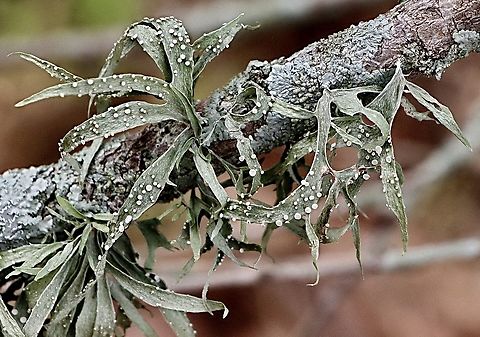
Appearance
"Ramalina celastri" typically forms a corticolous thallus, which is the main body of the lichen, characterised by its rigid, erect to somewhat pendulous structure that can reach up to 15 cm in length. The thallus emerges from an often broad base and has sparing to moderate branching. The branches have a colour ranging from straw-colored to pale green. These branches are solid and flattened, with a lanceolate form that can be either plane or slightly canaliculate. The width of these branches is quite variable, ranging from 1 to 20 mm, though they most commonly measure between 3 and 5 mm. Young branches are thin and more or less smooth, transitioning as they age to develop longitudinal or reticulately ridged surfaces. These textures result from strands of cartilaginous tissue, and the branches often have holes or cracks. Short linear or irregular laminal pseudocyphellae, are commonly present but soralia, which are structures for asexual reproduction, are absent.Reproductive features of "Ramalina celastri" include numerous apothecia. These are predominantly found lateral and laminal on the thallus and are supported by a stipe. The disc of the apothecia may be flat or convex, surrounded by a smooth thalline exciple, which is the rim of tissue around the disc. The spores measure 4–7 by 11–16 μm. "Ramalina celastri" lacks any medullary substances as confirmed by thin-layer chromatography. The only secondary metabolite it contains reliably is usnic acid; atranorin is an accessory substance, meaning that it is sometimes present, sometimes not present.
Distribution
"Ramalina celastri" is widely distributed in tropical areas of the world. It grows on bark and on wood, and is found on trees, shrubs, and wooden posts, it has also been noted to occasionally grows on rocks. It is typically found in the warmer and more humid regions of Australia, specifically in New South Wales and Queensland, as well as in northern New Zealand. In New Zealand, the rock-dwelling forms of "Ramalina celastri" on the North Island, found exclusively within coastal environments, showed distinct morphological differences from their tree-dwelling counterparts, characterised by a more robust structure with wider and longer thalli. Additionally, in cross-section, the medulla of saxicolous specimens was found to be thicker. In East Africa, the lichen is common and widespread at elevations between 800 and 3,400 m. It is less common in Brazil than in other tropical countries. "Ramalina celastri" has also been recorded from India. Its range in North America extends north to southern Texas.References:
Some text fragments are auto parsed from Wikipedia.